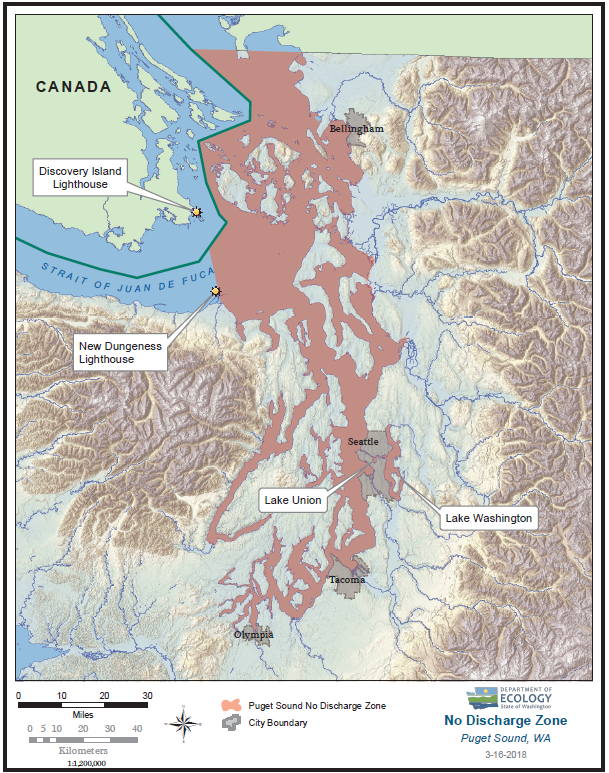Commercial vessels
It is now illegal for all commercial vessels to discharge treated or untreated sewage into Puget Sound. Chapter 173-228 WAC was adopted on April 9, 2018. The rule is effective as of May 10, 2018. There are a few exceptions and exemptions explained below or in our focus sheet.
Puget Sound is a unique and sensitive environment that is prone to poor water quality conditions. A no discharge zone (NDZ) addresses this source of preventable pollution from impacting shellfish beds, beaches, and water quality.
All vessels now should follow no discharge zone rules
Because of costs and efforts to change systems, the vessels defined below had until May 10, 2023, to comply with the no discharge zone specific rules. All other vessels (not listed below) had to comply with the rule May 10, 2018.
What is the boundary of the NDZ?
All the marine waters of Washington state inward from the line between New Dungeness Lighthouse (N 48°10'54.454", 123°06'37.004" W) and the Discovery Island Lighthouse (N 48°25'26.456", 123°13'29.554" W) to the Canadian border (intersecting at: N 48°20'05.782", 123°11'58.636" W), and fresh waters of Lake Washington, Lake Union, and connecting waters between and to Puget Sound.Public vessels emergency exemption
There is an exemption for any public vessels that are actively involved in emergency, safety, security, or related contingency operations where it would not be possible to comply with the no discharge zone.Public vessels means: a vessel owned or bareboat chartered and operated by the United States, by a state or political subdivision thereof, or by a foreign nation, except when such vessel is engaged in commerce.
How to manage vessel sewage in the NDZ
All Marine Sanitation Devices (MSDs) installed on all vessels must meet the requirements of 40 C.F.R Part 140 and be:
- Designed and operated to either retain, dispose of, or discharge sewage.
- Certified by the US Coast Guard.
Type III holding tanks
Vessels with these MSDs must follow requirements to use stationary pumpouts, mobile pumpouts, pumping services (barges, trucks), or discharge outside the NDZ. Read the list of potential commercial vessel sewage pumpout options.
Type I or Type II devices
Vessels with these MSDs must secure each device in a manner which prevents discharge of treated or untreated sewage while in the NDZ, following the reqirements of 33 C.F.R. Part 159.7(b). Acceptable methods of securing the device include:
- Closing the seacock and removing the handle
- Padlocking the seacock in the closed position
- Using a non-releasable wire-tie to hold the seacock in the closed position
- Locking the door to the space enclosing the toilets with a padlock or door handle key lock
Without installed toilets
Vessels without installed toilets must dispose of any collected sewage from portable toilets or other containment devices at facilities that comply with state law (ashore in proper facility).
Enforcement
Our approach is first focused on outreach and education. We partner with the NDZ Enforcement Committee and NDZ Outreach and Education Committee on enforcement provisions and outreach and education.
However, it's the law. Your MSD may be inspected and you could be fined (Chapter 90.48 RCW, Chapter 173-228 WAC). Ecology and the United States Coast Guard may enforce this rule by using the enforcement provisions in Chapter 90.48 RCW or other federal provisions. In addition, other federal, state, and local agencies may provide enforcement, as authorized.
Contact information
Amy Jankowiak
No Discharge Zone Project Lead
amy.jankowiak@ecy.wa.gov
425-429-4259
Evan Dobrowski
No Discharge Zone Compliance Specialist
evan.dobrowski@ecy.wa.gov
425-213-4230


